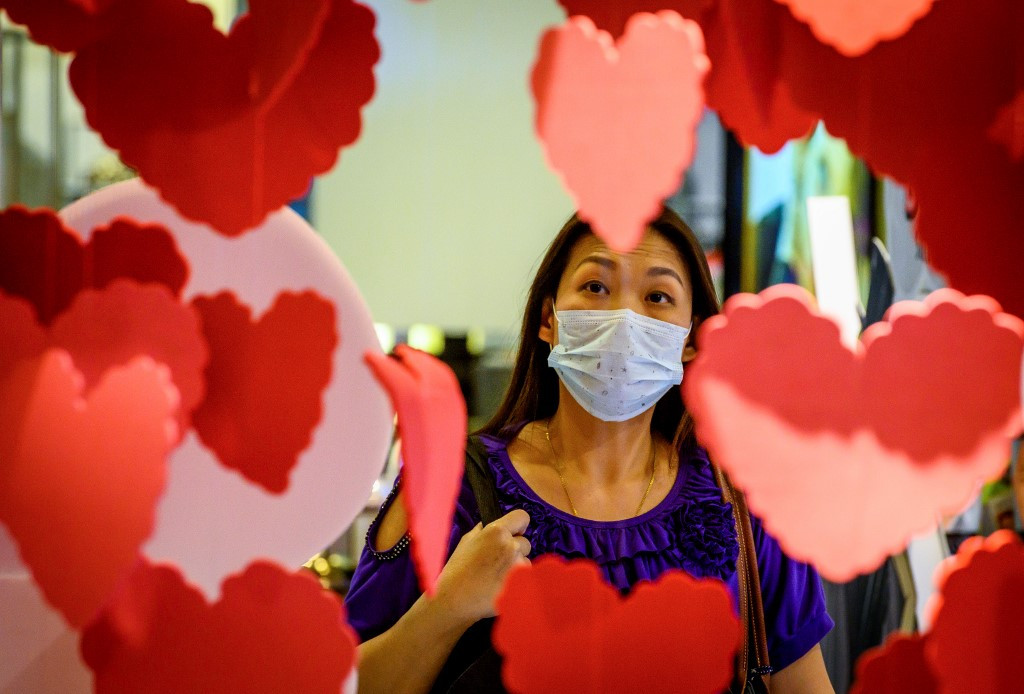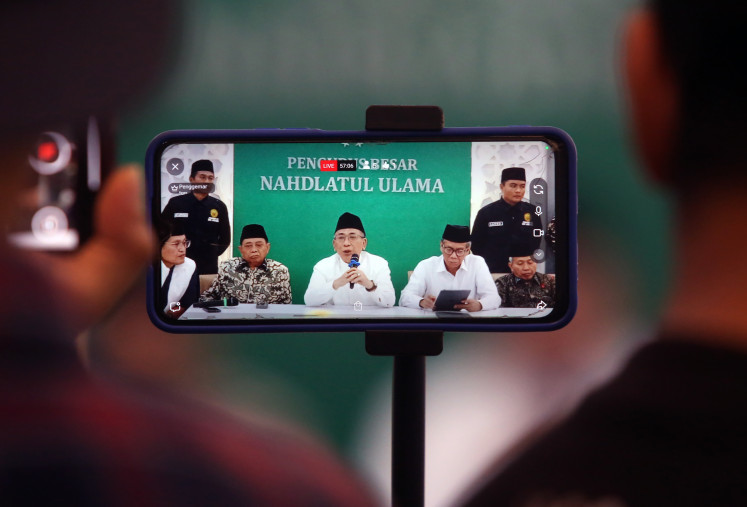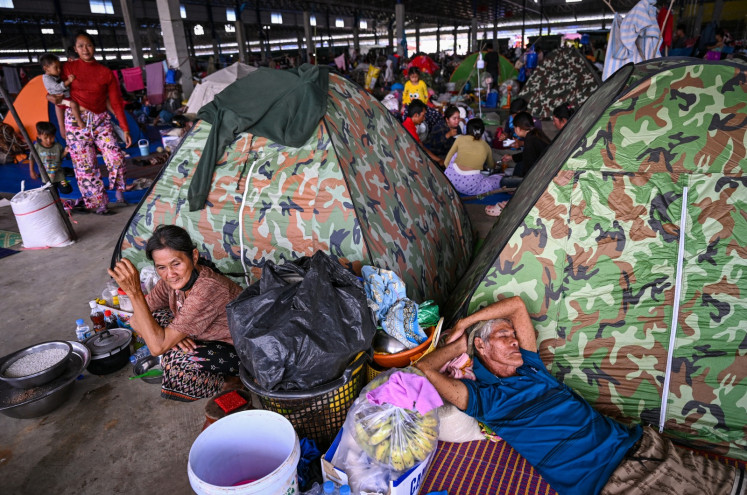Popular Reads
Top Results
Can't find what you're looking for?
View all search resultsPopular Reads
Top Results
Can't find what you're looking for?
View all search resultsJoining hands to fight the 2019-nCov epidemic
The actions of China’s government and people are key to the global campaign against this epidemic.
Change text size
Gift Premium Articles
to Anyone
 A woman wearing a protective facemask walks behind Saint Valentine's decorations in a shopping mall in Bangkok on February 11, 2020. - The death toll from the novel coronavirus outbreak surged past 1,000 in China on February 11 as the World Health Organization warned that the epidemic poses a (AFP/Mladen ANTONOV)
A woman wearing a protective facemask walks behind Saint Valentine's decorations in a shopping mall in Bangkok on February 11, 2020. - The death toll from the novel coronavirus outbreak surged past 1,000 in China on February 11 as the World Health Organization warned that the epidemic poses a (AFP/Mladen ANTONOV)
T
he novel coronavirus (2019-nCov) epidemic has become a common international concern. Since the first infection was diagnosed in Wuhan, China, in December 2019, the coronavirus has been spreading at a speed beyond expectations. China’s government mandated a quarantine of Wuhan city on Jan. 23 and 31 provinces and municipalities have also taken first-level response measures to this major public health emergency.
On Jan. 30, the World Health Organization declared the epidemic a global health emergency.
The actions of China’s government and people are key to the global campaign against this epidemic. Why has China’s government taken such strong measures? How effective are they? What are the epidemic’s effects on China’s economy? And how can the international community together tackle the international emergency?
Here are some tentative answers by experts of the Institute of Global Governance of the Shanghai Institute for International Studies.
1. Why were mass quarantines imposed on Wuhan and other epidemic areas?
Quarantine is a traditional yet most effective measure to contain a deadly epidemic. With no cure for virus-caused infections, standard public health emergency measures usually prove the most efficient, including isolating the sources of infection, cutting off or interrupting transmission routes and providing special care for the most susceptible people.
Humans are all susceptible to this deadly new coronavirus; thus source isolation and transmission chain interruption are by far the only reliable and effective methods. The unprecedented full quarantine on Wuhan reflects China’s dedication as a responsible great power.
Since the quarantine began, the number of confirmed cases in all regions has grown at a much lower speed than in Hubei province; and Wuhan remains the only city with concentrated infections.
Of all confirmed cases outside Hubei, most patients have either lived in or traveled to Wuhan or other areas of Hubei recently, and the rest have been in close contact with the above patients. High-level emergency alerts have been activated all across China.
Travelers from Wuhan and other epidemic areas are advised to report their travel records and to self-quarantine for two weeks to prevent transmission.
Reportedly, 5 million people who had left Wuhan before the lockdown were migrant workers seeking family reunions in their hometowns or holiday travelers.
What if China had not closed off Wuhan and other epidemic areas? Highly connected transport networks may enable pathogens to cross six continents in under 36 hours.
Yet by Jan. 30, eight days after the Wuhan lockdown, 18 countries had reported 98 scattered cases of infection, the WHO reported.
As WHO director-general Tedros A. Ghebreyesuson said, “the Chinese government is to be congratulated for the extraordinary measures [...].”
The Commerce Ministry has activated a material supplying mechanism involving nine provincial authorities, through which basic items flow into Hubei.
The Chinese traditionally store more than enough food and other items for the Spring Festival season. Although Wuhan’s public transportation has been suspended, residents have not been restricted and most households have opted for self-quarantine to avoid potential infection. Community organizations offer vehicles for those who must travel.
Locals’ lives have begun to return to normal with the regular disclosure of information and stepped-up personal hygiene measures.
Hubei province has 72 A-grade hospitals and 942 other medical facilities. Two of China’s top ten hospitals are in Wuhan, along with 229 other medical facilities. Medical institutions across China stand ready to assist Wuhan at request and medical personnel are arriving in Wuhan to reinforce its public health system.
Following the model of Xiaotangshan Hospital built in 2003 to treat Severe Acute Respiratory Syndrome (SARS) patients in Beijing, three new hospitals have been erected in Hubei, including the Huoshenshan Hospital (with 1,000 beds and covering 34,000 square meters) and Leishenshan Hospital (with 1,500 beds and spanning 75,000 square meters) in Wuhan, scheduled to be ready within 10 days after plans for construction were made.
2. Can the Chinese government contain the epidemic?
Beijing activated the public health emergency response mechanism as soon as the number of confirmed cases rose to 200. On Jan. 20, President Xi Jinping and Premier Li Keqiang instructed all levels of government to pay their closest attention to the epidemic’s development.
On Jan. 25, Premier Li was designated chair of a new central group on battling the epidemic. Over 52 batches of 6,097 medical professionals are working in Wuhan and other places in Hubei.
The Finance Ministry has allocated 1 billion yuan (US$143.4 million) in emergency funds for Wuhan and Hubei. Food and other necessities have been sent from other places to Wuhan for its 9 million residents.
Most of the confirmed cases reported outside Hubei are imported infections — patients who have either traveled to or lived in Wuhan or come into close contact with carriers of the virus. There have been no other epicenters other than Wuhan thanks to early intervention.
Priorities for local governments include identifying and caring for symptomatic patients and advising and monitoring people with records of travel to Wuhan to self-quarantine.
Measures such as migration control and mass quarantine may cause social disorder, requiring appropriate responses from local authorities. Price control and quality supervision are also necessary amid soaring demands for face masks and liquid soap.
In rural areas, many remain reluctant to wear masks and to wash their hands with soap. Family reunions during the Spring Festival also increased the likelihood of mass infection.
Financial and material donations from enterprises have been growing since the onset of the virus. Corporate giants like Alibaba and Fosun International Limited have made overseas purchases of medical equipment for Wuhan.
Chinese tech firms have proven that the internet plays a special role in China’s social governance. Tencent has set up 11 platforms providing online services such as up-to-date information and medical advice. Another platform helps debunk rumors. Didi, a car-hailing service firm, has set up a convoy to ferry medical staff amid Wuhan’s shutdown
Since the SARS outbreak, internet companies have shouldered increasing corporate responsibilities in times of crisis.
The public has experienced a quiet Spring Festival, with canceled gatherings and vacations. Despite initial anxiety, criticism and concerns over information disclosure, the public rationality in a country with a population of 1.4 billion and 800 million netizens has been commendable.
With the government’s enhanced information transparency, criticism was replaced with optimism and support for government initiatives and programs.
Now, the public is admiring the medical staff from across China working in Wuhan, hailing Zhong Nanshan — the first professional to warn of human-to-human transmission — as a national hero, and watching live at 3 a.m. the construction of hospitals with chants of “Hang on Wuhan, we stand with you.” Today, more and more Chinese are comforting and encouraging each other.
Besides donations to charities and Red Cross agencies, the public has mailed to Wuhan masks and protective suits. Social groups have volunteered to work in Wuhan. Overseas members of alumni societies of Wuhan University, Nanjing University and Tsinghua University have provided medical materials to Wuhan hospitals. Medical associations have volunteered to counsel patients’ families.
In Shanghai, residents sent frontline medical personnel milk tea and meals. Some placed hundreds of face masks at a police station’s entrance without leaving their names.
The third question that many have raised is the likely impact of the novel coronavirus epidemic on China’s economy.
There are three main views about what impact the epidemic will have on China’s economy.
The “critical impact” theory maintains that the epidemic will have a serious effect on the [now slackening economy, slowing its growth rate and handicapping the global economy.
Based on data about the economic impact of the Severe Acute Respiratory Syndrome (SARS) in 2003, the “manageable impact” theory holds that the epidemic will have a limited effect on China’s economy, and that the performance of the whole year will not be much influenced despite slowed growth in the first quarter.
The “uncertain impact” theory holds that the economic impact will depend on how long the epidemic lasts. The size of China’s economy (99 trillion yuan in gross domestic product) is nine times the size it was 2003 (11.7 trillion yuan).
Indeed, it would be imprudent to judge the epidemic’s economic impact by historical experience. In the new millennium, China has witnessed epidemics, disasters and other acute incidents.
Yet the government has managed to contain them one by one, including SARS in 2003 (which caused the biggest short-term economic effect), H1N1 (swine flu) in 2009 and H7N9 (bird flu), as well as the 2008 Wenchuan earthquake.
Even in the face of the 2009 global financial crisis, China maintained steady economic growth with a strong stimulus package and international efforts led by the Group of 20.
However, the potential impact of this epidemic could be different from all previous epidemics and other incidents.
For one, it has occurred when China’s economy is facing three daunting tasks domestically: guarding against systemic financial risks, pollution control and poverty eradication. Externally, with globalization under unprecedented challenges and China-United States trade frictions only starting to ease, China’s economy will be further hit if it is labeled an “epidemic area”.
The epidemic has also influenced larger areas and to greater degrees. Not only is it the first time in history that a complete quarantine has been placed on Wuhan city and that first-level responses have been enacted by more than 30 provinces or municipalities, but the epidemic has also impacted employment, local government debts and the stability of the yuan. Economic growth is forecast to decline 1.5 percentage points.
The epidemic poses the danger of direct harm to three main sectors: the service sector, especially tourism, catering, entertainment and logistics; the manufacturing sector, typically the mobile phone, automobile and electronic industries, which could disrupt global industrial chains; and the trade sector, owing to potential cuts or even a shutdown of airline routes, sea routes and borders by some countries.
Nevertheless, the resilience of China’s economy cannot be underestimated. The epidemic has benefited industries such as electronic commerce and online gaming and entertainment.
The government boasts strong financial capacity in crisis management — as of Jan. 29, 27.3 billion yuan (US$3.9 billion) had been provided by governments of all levels for epidemic control.
Some Americans doubt if China can fulfill its commitment made in the Phase I deal with the US; however China’s purchase of American agricultural products could reach a new high, as the deal ended much of the uncertainty of China-US trade relations.
Besides, China will likely increase its purchases of other products, such as medical supplies. Notably, the epidemic will be taken into full consideration in the making of China’s 14th Five-Year Plan (2021-2025). As the world’s second largest economy, the epidemic cannot undermine China’s huge potential in consumption, urbanization and new economic fields such as 5G and artificial intelligence.
4. How can the international community work together in the interests of common human security?
In our globalized world, the epidemic will inevitably have global impacts. China has been striving to fulfill its international responsibilities and obligations to counter the epidemic. With utmost openness and promptness, the government is working closely with the World Health Organization at every step, as exemplified by President Xi Jinping's meeting with WHO director-general Ghebreyesus on Jan. 28.
After he declared the epidemic a global health emergency, China’s mainstream media reported the news immediately, indicating that the government has nothing to hide.
Next, the government has given its full understanding and assistance to other governments in their actions to prevent the spread of the epidemic, such as the evacuation of their citizens from Wuhan and their decisions to halt flights to China.
Furthermore, the government has remained open and grateful to all kinds of assistance from other countries. China is considering promoting such cooperation in the event of future epidemics around the world.
Finally, both the government and public opinion are quite concerned about the epidemic’s global impact. The government has been trying to minimize the spread of the epidemic to other countries by increasing its control of overseas travel by populations in the worst-hit regions and calling on the public to prevent the dissemination of the virus.
We recommend the international community take these actions for our common security: First, optimize the distribution of up-to-date information. China’s daily “epidemic bulletin” plays a key role. The bulletin is provided in multiple languages of neighboring countries such as Russian, Japanese, Korean and English, so that factual information and data can be accessed to counter the spread of fake news and rumors.
Successful government actions to prevent the spread of the virus be also be explained in detail in the bulletin as well. The real-time bulletin should be provided in multiple languages on the websites of the Foreign Ministry and Chinese embassies and consulates abroad. International media and think tanks should maintain an objective, comprehensive and humane stance when reporting or conducting analysis on the epidemic and avoid hyping unconfirmed information or even rumors.
Second, the international community must strengthen the international exchange of experience in epidemic control. China should translate the latest “Guidelines for preventing the 2019-nCoV” into different languages and pass it to neighboring countries swiftly and in multiple forms. This will also contribute to China’s image as a “kind neighbor” and “responsible great power”. We call for more support from the US, the European Union and other developed countries in the provision of medical equipment and supplies, as well as their best practices in epidemic control.
Third, the international community must oppose discrimination against people from epidemic-struck regions. The epidemic must not become a new barrier between countries, but should be turned into a new bridge across nations. China’s Foreign Ministry and its missions are in close contact with the governments and health agencies of other countries, updating them with the latest progress in countering the epidemic.
Chinese communities abroad are also keeping a close eye on the health of Chinese people in their neighborhoods, and are ready to help local epidemic prevention agencies, if necessary, to provide health certifications, so as to prevent any ugly anti-Chinese events being spark by a lack of information.
We advise the publics of all countries to remain calm and avoid discrimination against Chinese people or any infected persons. For we, as human beings, are one family and no ethnic group can stand immune to our common challenge.
***
President of the Shanghai Institute for International Studies (SIIS). The following is part one of a two-part abridged version of a report from the SIIS task force on global governance, Coronavirus Battle in China: Process and Prospect, published on Feb. 1. The report’s coauthors are Liu Kan, Lu Chuanying, Zhang Haibing, Ye Jiang and Qiang Xiaoyun.










